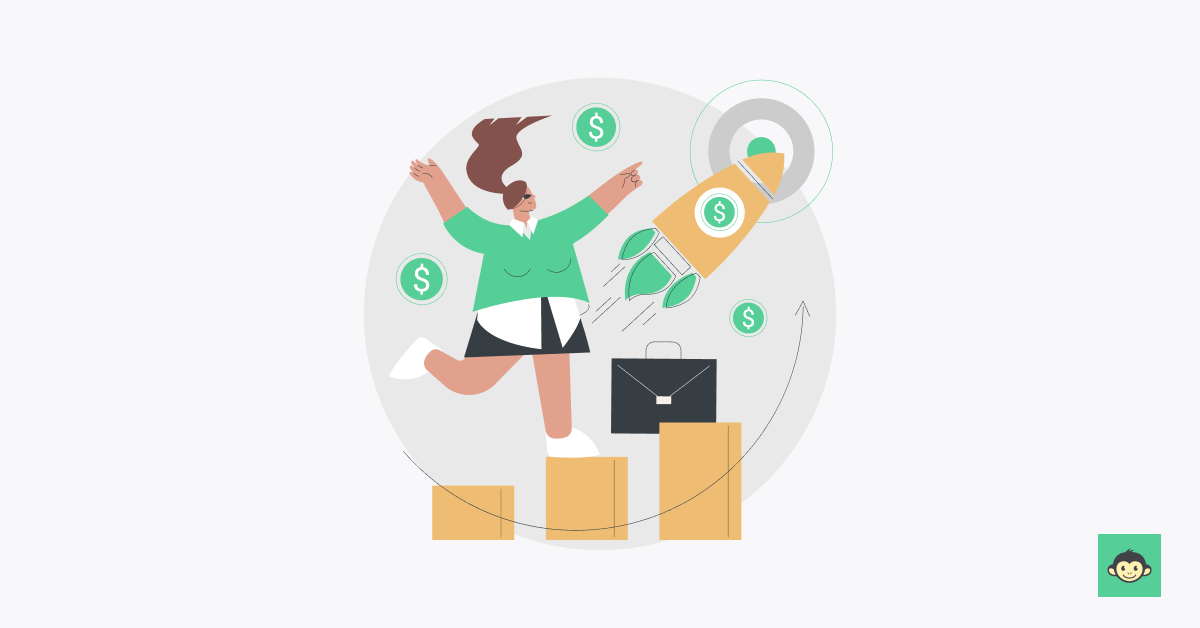What is a retention bonus: Best practices to improve your retention strategy in 2024

In today's competitive job market, holding onto high-performing employees feels like wrangling greased pigs. They're constantly bombarded with enticing offers, leaving you scrambling to fill talent gaps and pick up the slack.
But fear not, there's a glimmer of hope in the form of the retention bonus. This financial incentive, strategically wielded, can be your key to securing the loyalty of your workforce and building a rock-solid team.
Ready to turn the tide on employee turnover and build a dream team? Buckle up, grab your coffee, and dive into this comprehensive guide to retention bonuses. It's time to regain control of your workforce and watch your business soar!
Retention bonus meaning

A retention bonus refers to a financial incentive offered by an employer to encourage employees to remain with the company for a specified period. It is a proactive measure employed by organizations to retain valuable talent, minimize turnover, and maintain stability within the workforce.
Retention bonuses are typically offered during times of organizational change, restructuring, or when there is a risk of key employees leaving the company.
The purpose of a retention bonus is to incentivize employees with critical skills, expertise, or experience to stay with the organization, thereby ensuring continuity in operations and preventing disruptions to business functions.
These bonuses are often structured as one-time payments or staggered installments, contingent upon the employee fulfilling predetermined conditions, such as remaining with the company for a certain duration or achieving specific milestones.
By offering retention bonuses, employers demonstrate their commitment to retaining top talent and recognize the value of retaining employees who contribute significantly to the company's success.
From understanding the psychology behind employee loyalty to crafting effective retention bonus agreements and structures, we'll delve into the key elements that can help you regain control of your workforce.
What are the objectives of the retention bonus?

The objectives of a retention bonus are multifaceted and aim to address various challenges associated with employee turnover in today's competitive job market. Here are some key objectives of most employee retention bonuses:
Retaining top talent:
Attracting and retaining high-performing employees is a primary objective. Retention bonuses are designed to encourage these valuable individuals to remain with the organization, minimizing the risk of losing key talent to competitors.
Reducing turnover costs:
Employee turnover comes with significant costs related to recruitment, onboarding, and training of new staff. The objective of a retention bonus is to offset these costs by persuading current employees to stay, thereby reducing the need for frequent hiring and training.
Ensuring continuity and stability:
Retention bonuses contribute to maintaining stability within the organization by preventing disruptions caused by frequent turnover. This is particularly crucial in roles where continuity is essential for the smooth functioning of operations.
Enhancing employee morale:
Knowing that their contributions are valued through financial incentives, employees may experience a boost in morale. This can lead to increased job satisfaction, productivity, and a positive workplace culture.
Fostering loyalty and commitment:
Retention bonuses are a proactive measure to build a sense of loyalty and commitment among employees. By demonstrating that the company is invested in their long-term success, employees are more likely to reciprocate with increased dedication and loyalty.
Addressing skill shortages:
In industries where specific skills are in high demand, organizations may use retention bonuses to address shortages and retain employees possessing critical expertise. This ensures the continuity of specialized knowledge within the company.
Strategic workforce planning:
Retention bonuses can be part of a broader strategic workforce planning initiative. Organizations use these incentives to align their human resource strategies with long-term business goals, ensuring they have the right talent in place for future challenges.
Competitive advantage:
Offering attractive retention bonuses can be a competitive advantage in the job market. It sets the organization apart as an employer of choice, making it more appealing to potential candidates and reinforcing a positive employer brand.
Improving employee engagement:
Engaged employees are more likely to stay with an organization. Retention bonuses can contribute to increased engagement by showing employees that their contributions are recognized and rewarded, fostering a sense of belonging and satisfaction.
Mitigating the impact of external offers:
In a market where employees often receive enticing offers from other companies, retention bonuses act as a preemptive measure to counteract the lure of external opportunities, providing a compelling reason for employees to remain with their current employer.
Supporting career development:
Retention bonuses can also be tied to career development opportunities within the organization. By offering financial incentives along with a clear path for advancement, employees are more likely to see their future within the company, thus increasing their motivation to stay and grow professionally.
Encouraging knowledge sharing:
Incentivizing employees to stay through retention bonuses encourages them to share their knowledge and expertise with colleagues. This fosters a culture of collaboration and continuous learning, ultimately benefiting the organization as a whole.
Promoting organizational stability:
In times of organizational change or uncertainty, retention bonuses can provide employees with a sense of stability and security. This helps to mitigate any potential negative effects on morale and productivity, allowing the organization to navigate transitions more smoothly.
By aligning these objectives with a well-designed retention bonus program, organizations can effectively address the challenges of employee turnover and create a more stable, engaged, and high-performing workforce.
How employee retention bonuses work?

Retention bonuses work by offering financial incentives to employees as a proactive measure to encourage them to stay with the organization for a specified period.
Unlike traditional bonuses tied to performance or company profitability, retention bonuses are specifically designed to address the challenges of employee turnover.
Here's a breakdown of how retention bonuses typically work:
- Identification of key employees: Employers identify key employees whose skills, experience, or contributions are critical to the organization's success. These are individuals whose departure could have a significant impact on operations.
- Negotiation and agreement: Employers often engage in negotiations with identified employees to discuss the terms of the retention bonus. The terms of sign on bonus may include the duration of commitment, the amount of the bonus, and any specific conditions or performance metrics tied to the bonus.
- Timely payouts: Retention bonuses are usually structured with a payout schedule. Rather than a lump sum payment, the bonus may be distributed over the agreed-upon period, serving as an ongoing incentive for the employee to remain with the company.
- Conditional commitments: To ensure that the employee remains committed to the organization, retention bonuses may be contingent upon specific conditions. These conditions could include the completion of a project, meeting performance targets, or a key employee staying until a critical business milestone is achieved.
- Customization for different roles: Retention bonuses can be customized based on the nature of the employee's role within the organization. For example, retention bonuses calculated for executives may differ from those for technical experts or sales professionals, reflecting the unique value each role brings to the company.
- Communication and transparency: Clear communication is crucial in the implementation of retention bonuses. Employers must transparently communicate the purpose of the retention bonus agreement, the expectations from the employee, and any factors that may influence the bonus payout.
- Integration with overall compensation strategy: Retention bonuses are integrated into the overall compensation strategy of the organization. This ensures that they align with other compensation components, such as the employee's base pay, salary, benefits, and performance-related bonuses, creating a cohesive and fair compensation package.
- Evaluation and adjustment of retention pay: Employers periodically evaluate the effectiveness of retention bonuses. This may involve assessing whether key employees have remained with the company, monitoring performance metrics, and making adjustments to the bonus structure as needed to address evolving business needs.
- Confidentiality: To maintain a positive work environment and avoid potential disruptions, the details of retention bonuses are often kept confidential. This helps prevent dissatisfaction among employees who may not be eligible for such incentives.
- Legal and compliance considerations: Employers need to ensure that retention bonuses comply with legal regulations and employment contracts. Legal consultation may be necessary to navigate potential issues related to labor laws, taxation, and contractual obligations.
What are the benefits of a retention bonus at work?

A retention bonus is a financial incentive offered by employers to encourage employees to stay with the company for a specified period. Here are the benefits of a retention bonus at work:
Cost savings:
Retention bonuses can result in significant cost savings for organizations by reducing expenses related to recruitment, onboarding, and training of new employees.
The financial investment in retaining current talent is often more economical than the costs associated with employee turnover.
Increased employee morale:
Offering retention bonuses contributes to a positive work environment by boosting employee morale.
Recognizing and rewarding the contributions of employees through financial incentives can enhance job satisfaction and overall morale within the workforce.
Enhanced productivity and performance:
Employees who feel valued and appreciated are likely to be more engaged and motivated.
Retention bonuses can translate into increased productivity and improved performance as employees are incentivized to invest their skills and efforts in contributing to the organization's success.
Competitive advantage in recruitment:
A well-structured retention bonus program can serve as a competitive advantage in the recruitment process.
It demonstrates to potential candidates that the organization is committed to retaining its top talent, making it an attractive employer in a competitive job market.
Knowledge retention:
Retention bonuses are particularly beneficial in retaining employees with specialized skills or knowledge critical to the organization.
This helps maintain continuity in operations, prevents knowledge gaps, and ensures the preservation of institutional knowledge.
Improved employee loyalty:
By offering financial incentives for employees to stay with the company, retention bonuses contribute to building a sense of loyalty.
Employees are more likely to remain committed to the organization when they perceive that their contributions are recognized and rewarded.
Strategic workforce planning:
Retention bonuses support strategic workforce planning by allowing organizations to retain key personnel aligned with long-term business goals. This helps ensure that the right talent is in place to meet future challenges and opportunities.
Reduced disruption:
Employee turnover can cause disruptions in workflow, team dynamics, and project timelines. Retention bonuses help minimize these disruptions by encouraging employees to stay, providing stability and continuity in day-to-day operations.
Positive employer branding:
A commitment to retaining talent through retention bonuses contributes to positive employer branding. This positive perception in the job market can attract top talent, reinforce the organization's reputation, and position it as an employer of choice.
Customized incentives for different roles:
Retention bonuses allow for the customization of incentives based on the unique contributions of employees in different roles. This ensures that the bonus structure reflects the value each role brings to the organization, promoting fairness and equity.
In summary, retention bonuses offer a range of benefits, including cost savings, improved morale, increased productivity, and a strategic advantage in recruitment.
These incentives contribute to a positive workplace culture and help organizations build a loyal and high-performing workforce.
Do retention bonuses work?

The effectiveness of retention bonuses in retaining employees varies depending on various factors such as organizational culture, industry dynamics, and individual employee motivations.
While retention bonuses can be successful in incentivizing some employees to stay with the company, they are not a guaranteed solution for reducing turnover.
Research suggests that while monetary incentives can influence short-term retention, they may not address underlying issues driving employee turnover, such as job dissatisfaction, lack of career growth opportunities, or poor work-life balance.
Additionally, reliance solely on retention bonuses may create a culture where employees stay primarily for financial reasons rather than genuine commitment to the organization's mission and values.
To maximize the effectiveness of retention bonuses, companies should complement them with comprehensive strategies that address broader aspects of employee engagement, satisfaction, and career development.
This may include fostering a positive work environment, providing opportunities for professional growth, and promoting a culture of recognition and appreciation.
When not to choose retention bonuses?

While retention bonuses can be effective in certain situations, there are scenarios where choosing them may not be the most appropriate or beneficial option. Here are instances when not to choose retention bonuses:
- Financial constraints: Organizations facing financial challenges or constraints may find it impractical to commit to retention bonuses, given the potential strain on financial resources. In such cases, alternative strategies should be explored to address employee retention.
- Widespread dissatisfaction: When there is a prevailing sense of dissatisfaction among employees due to broader organizational issues, relying solely on retention bonuses may not effectively address the root causes. It becomes crucial to prioritize comprehensive strategies that enhance morale and engagement.
- Short-term commitment: Key staff members expressing a short-term commitment or exhibiting a history of frequent job changes may not be the ideal candidates for retention bonuses. Exploring alternative methods, such as professional development opportunities or percentage method, could be more suitable.
- Lack of clear objectives: Organizations without clear objectives or a well-defined retention bonus program may struggle to achieve desired outcomes. It's essential to establish transparent communication about the purpose, terms, and conditions of the retention bonus program.
- Legal or ethical concerns: Instances where legal or ethical concerns, such as non-disclosure agreements or guaranteeing employment, pose challenges should prompt a careful reevaluation of retention bonus strategies. Addressing these issues ensures compliance with regulations and fosters positive employer-employee relationships.
- Ineffective communication: In cases where there is a lack of transparent communication about the employee retention bonus work program, managing employee expectations becomes challenging. Clear communication is pivotal to the success of any retention initiative.
- Uncertain business outlook: When an organization is facing significant uncertainty regarding its future direction or market stability, relying solely on retention bonuses may not be prudent. In such situations, it's essential to evaluate broader strategies that address the overall business outlook and mitigate potential risks.
- High turnover rates: If the organization experiences consistently high turnover rates across various departments or job roles, retention bonuses alone may not be sufficient to address underlying issues. A comprehensive approach to talent management, including recruitment, training, and organizational culture, may be more effective in reducing turnover.
- Cultural misalignment: When there is a significant disconnect between the organizational culture and the values or expectations of employees, retention bonuses may not effectively improve retention. Addressing cultural misalignment through targeted initiatives and fostering a positive work environment is essential for long-term employee satisfaction.
Refraining from retention bonuses is advisable when faced with financial constraints, widespread dissatisfaction, short-term commitments, unclear objectives, legal concerns, or ineffective communication.
9 Retention bonus best practices to follow

Implementing retention bonuses can be a strategic approach to foster employee loyalty and minimize turnover. To ensure the effectiveness of your retention bonus program, consider these seven best practices:
- Define clear objectives: Clearly articulate the objectives of your retention bonus program. Whether it's retaining key employees, addressing skill shortages, or fostering long-term commitment, having well-defined goals will guide the structure and implementation of the program.
- Customize bonus structures: Tailor retention bonuses to align with the unique contributions of different roles within the organization. Consider variations based on factors such as job responsibilities, skill levels, and the impact of the employee's salary on critical projects or initiatives.
- Transparent communication: Communicate openly and transparently with employees about the purpose and terms of the retention bonus program. Clear communication builds trust and helps manage expectations, reducing the likelihood of misunderstandings.
- Align with overall compensation strategy: Integrate retention bonuses seamlessly into the organization's overall compensation strategy. Ensure that the bonus program complements other components of employee compensation, such as base pay, salary, benefits, and performance-related bonuses.
- Regular evaluation and adjustment: Periodically assess the effectiveness of the retention bonus program. Evaluate whether key employees are staying with the company, monitor performance metrics, and be prepared to make adjustments to the bonus structure as needed to address evolving business needs.
- Compliance with legal and ethical standards: Ensure that the retention bonus program complies with legal regulations, employment contracts, and ethical standards. Seek legal counsel to navigate potential issues related to labor laws, taxation, and contractual obligations, maintaining the program's integrity.
- Consider tax implications: A retention bonus is seen as income by the Internal Revenue Service (IRS) even though they're supplemental wages and not base salaries. Consult with tax professionals to navigate tax withholding, reporting requirements, and other relevant considerations to ensure compliance with regulations.
- Employee feedback integration: Incorporate employee feedback into the design and evaluation of the retention bonus package. Soliciting input from staff members can provide valuable insights into their preferences, concerns, and perceptions, enabling the organization to tailor the program more effectively to meet their needs.
- Account for long-term sustainability: Ensure that the retention bonus program is sustainable over the long term and aligns with the organization's financial capabilities. Consider factors such as budget constraints, revenue projections, and potential fluctuations in business conditions when designing and implementing the program.
By incorporating these best practices, organizations can enhance the effectiveness of their retention bonus programs, fostering a positive work environment and retaining key talent in the competitive job market.
Examples of employee retention bonuses to get inspiration from

Employee retention bonuses can take various forms, tailored to the organization's goals and industry. Here are some examples to inspire different approaches:
- Targeted retention bonus paid for key employees: Design a retention bonus program specifically targeting key employees whose contributions are vital to the organization's success. This approach ensures that the most valuable individuals are acknowledged and motivated to stay.
- Role-based incentives: Implement role-based retention bonuses by customizing incentive structures based on the unique responsibilities and skill sets of different positions within the company. This approach recognizes the diverse contributions of employees across various roles.
- Performance-linked retention bonuses: Combine performance metrics with retention bonuses to create a dynamic incentive system. Employees who not only stay with the organization but also meet or exceed performance expectations can receive additional bonuses, reinforcing a culture of excellence.
- Tiered bonus structures: Develop tiered bonus structures that escalate with the employee's length of service or level of expertise. This encourages employees to commit to the organization for an extended period and provides increasing rewards for their loyalty and contributions.
- Project completion bonuses: Offer retention bonuses tied to the successful completion of significant projects or milestones. This approach ensures that employees remain engaged and committed until critical objectives are achieved, aligning their efforts with the organization's strategic goals.
- Skill retention packages: Create skill retention packages by identifying employees with specialized skills crucial for the company's operations. Tailor bonuses to retain these individuals, addressing skill shortages and securing the continuity of specialized knowledge.
- Long-term retention period vesting plans: Introduce long-term retention bonus vesting plans, where bonuses are distributed over an extended period, contingent on the employee's continued commitment. This approach promotes sustained loyalty and reduces the risk of premature departures.
- Retention bonuses for senior executives: Develop retention bonus programs specifically tailored for senior executives or leadership positions. This ensures that top-level talent crucial for strategic decision-making is incentivized to stay and contribute to the organization's success.
- Hybrid bonus programs: Combine retention bonuses with other supplemental wages, such as sign-on bonuses or other annual salary and performance bonuses, to create a comprehensive hybrid bonus program. This approach addresses multiple aspects of employee motivation and satisfaction.
- Targeted industry competitiveness: Research industry standards and competitor practices to ensure that your retention bonuses are competitive in the market. Benchmarking against industry norms helps attract and retain talent in a highly competitive job market.
- Health and wellness incentives: Introduce health and wellness incentives alongside retention bonuses to promote employee well-being. This can include benefits such as gym memberships, mental health resources, or wellness programs aimed at supporting employees' physical and emotional health.
These retention bonus examples provide inspiration for creating a customized program that aligns with your organization's goals and addresses the unique needs of your workforce.
What is a retention incentive?

A retention incentive is a strategic tool utilized by organizations to encourage current employees to remain with the company for a specified period. Unlike traditional bonuses tied to performance or annual rewards, retention incentives are specifically designed to address the risk of employee turnover.
These incentives typically consist of monetary rewards, additional benefits, or other perks offered to employees who commit to staying with the organization for a predetermined duration. Retention incentives aim to retain valuable talent, particularly individuals with critical skills or experience vital to the company's success.
By offering incentives tailored to employee needs and preferences, organizations can mitigate the costs and disruptions associated with employee turnover while fostering a sense of loyalty and commitment among their workforce.
How to improve long-term employee retention?

Improving long-term employee retention is a critical goal for organizations seeking stability and sustained success. Here are effective strategies to enhance employee retention over the long term:
- Cultivate a positive work environment: Foster a workplace culture that promotes positivity, collaboration, and a sense of belonging. A supportive environment contributes to job satisfaction, making employees more likely to stay for the long haul.
- Provide opportunities for professional growth: Invest in continuous learning and development programs to help employees enhance their skills and advance in their careers within the organization. Opportunities for growth can significantly contribute to employee satisfaction and commitment.
- Recognize and reward contributions: Acknowledge and reward employees for their hard work and achievements. Recognition programs, performance bonuses, and other forms of appreciation contribute to a positive work experience, fostering a sense of value and loyalty.
- Offer competitive compensation and benefits: Ensure that employee compensation is competitive within the industry. Additionally, provide comprehensive benefits packages, including health insurance, retirement plans, and other perks that contribute to overall job satisfaction and retention.
- Establish clear career paths: Outline clear career progression paths for employees, demonstrating potential avenues for advancement within the organization. Clear career trajectories provide motivation and a sense of purpose, reducing the likelihood of employees seeking opportunities elsewhere.
- Encourage work-life balance: Promote a healthy work-life balance by implementing flexible work arrangements, telecommuting options, or compressed workweeks. This flexibility supports employee well-being and satisfaction, contributing to long-term retention.
- Create a strong leadership pipeline: Develop a robust leadership development program to identify and groom internal talent for leadership roles. Opportunities for advancement within the organization can inspire employees to commit to long-term careers.
- Build a diverse and inclusive workplace: Prioritize diversity and inclusion efforts within the workplace. A diverse and inclusive environment fosters a sense of belonging and ensures that employees from various backgrounds feel valued and appreciated.
- Implement employee wellness programs: Support employee well-being by implementing wellness programs that focus on physical, mental, and emotional health. Healthier and happier employees are more likely to stay committed to their roles and the organization.
- Conduct stay interviews: Regularly conduct stay interviews to understand employee needs, concerns, and aspirations. Proactively addressing issues and aligning organizational strategies with employee expectations can enhance long-term retention.
- Offer retention bonuses: Consider implementing retention bonus programs strategically to reward and incentivize key employees to stay with the company for an extended period. Thoughtfully designed retention bonuses can contribute to building a committed and loyal workforce.
By incorporating these strategies, organizations can create an environment that nurtures employee satisfaction, loyalty, and long-term commitment, ultimately improving overall retention rates.
What does the company need to include in the agreement?

When implementing a retention bonus program, it is essential for companies to formalize the terms and conditions in a written agreement to ensure clarity and mutual understanding between the employer and employees.
This agreement serves as a legally binding document outlining the specifics of the retention bonus arrangement and the expectations of both parties involved.
- Eligibility criteria: Clearly define the criteria that determine an employee's eligibility to receive the retention bonus. This may include factors such as job role, tenure with the company, performance metrics, or other predetermined qualifications.
- Bonus amount and structure: Specify the amount of the retention bonus and outline the structure of the payment, including any conditions or milestones that must be met to qualify for the bonus. Clearly articulate whether the bonus will be a one-time payment or distributed over multiple periods.
- Payment schedule: Detail the payment schedule for the retention bonus, including the frequency and timing of payments. Whether the bonus will be paid in a lump sum or staggered over time, it is essential to provide clarity on when employees can expect to receive the bonus.
- Terms of employment: Reiterate the terms of employment, including any obligations or commitments that employees must fulfill to remain eligible for the retention bonus. This may include maintaining satisfactory performance, adhering to company policies, or fulfilling specific job responsibilities.
- Clawback provisions: Include provisions outlining circumstances under which the company may claw back or recoup the retention bonus from employees. This could occur if an employee voluntarily resigns or is terminated for cause within a certain timeframe after receiving the bonus.
- Confidentiality and non-disclosure: Incorporate clauses regarding confidentiality and non-disclosure to protect sensitive information related to the retention bonus program and its terms. Employees should understand their obligations to keep the details of the agreement confidential to maintain the integrity of the program.
Role of employee retention software in retaining your key employees in 2024

In 2024, employee retention software plays a pivotal role in retaining top talent by providing organizations with advanced tools to analyze, monitor, and enhance the employee experience. These software solutions leverage data-driven insights to identify potential turnover risks, allowing proactive measures to be taken.
Through features such as personalized career development plans, continuous feedback mechanisms, and real-time performance analytics, employee retention software facilitates a more engaging and supportive work environment.
Additionally, these platforms often integrate with talent management systems, enabling seamless coordination in talent retention strategies.
In a competitive job market, the role of employee retention software is indispensable, empowering companies to strategically address the evolving needs and expectations of their top performers, ultimately fostering long-term commitment and satisfaction.
Conclusion
As organizations navigate the challenges of retaining top talent in 2024, the role of employee retention software is undeniable, and the significance of a retention bonus cannot be understated.
CultureMonkey, with its advanced features and data-driven insights, emerges as a valuable partner in creating a workplace culture that fosters employee satisfaction and long-term commitment.
To revolutionize your talent retention strategies and build a culture that resonates with your team, explore the capabilities of CultureMonkey today!
FAQs
Is retention bonus paid every year?
No, retention bonuses are not typically paid every year. Retention bonuses are typically offered as a one-time incentive to encourage employees to stay with the company for a specified period, usually a year or more. However, some organizations may choose to offer a retention bonus on a recurring basis, such as annually, as part of their overall retention strategy.
When is retention bonus paid?
Retention bonuses are typically paid out at predetermined intervals, often after the employee has fulfilled certain conditions or milestones specified in the agreement. These milestones may include completing a specific length of employment, achieving performance targets, or remaining with the company through a critical period. The timing of retention bonus payments varies depending on the terms of the agreement.
What percentage should be used for the retention bonus?
Determining the percentage for a retention bonus depends on various factors, including industry standards, company budget, and the value of retaining the employee. High-demand roles or employees with critical skills may warrant higher percentages to incentivize retention. Additionally, organizations may consider benchmarking against competitors' practices and conducting cost-benefit analyses to determine an appropriate percentage.
Cons of retention pay
While retention pay can incentivize employees to stay with the company, it also has several potential drawbacks. One con is the financial strain it places on the organization, especially if bonuses are substantial or offered to numerous employees. Additionally, reliance on retention pay may create a culture where employees stay solely for financial incentives rather than genuine commitment to the company.
Who is eligible for a retention bonus?
Eligibility for a retention bonus typically depends on various factors, including the organization's policies, the employee's role, and the specific circumstances prompting the retention bonus. Generally, employees who possess critical skills, hold key positions within the company, or are deemed essential to the organization's success may be eligible for retention bonuses.



